
 Reflection, By Mariu Suarez, 58"x58", Oil and egg-tempera on canvas |
|
" Dreams – A microscope through which we look at the hidden occurrences in our soul."
- Erich Fromm |
Dreams: Tools for Healing
If a dream is a psychic happening, what is the psyche? Psyche is the word the Greeks used to name the three levels of personal consciousness. It is the equivalent of Anima in Latin, Soul in English and Alma in Spanish.

Our personal psyche is the result of eons of evolution, from the single cell to our species as it is right now. It has three components: The Intellectual Nature; the Feeling Nature; and Energy. Whatever we think, makes molds, which compress the Energy into a pattern. The same happens with our emotions. This is why it is vital to understand all the levels in our psyche to become aware of the patterns that drive us. The only way to accomplish that is by listening to the messages it sends us through our dreams.
How the Psyche Communicates
During the day, the attention of consciousness is focused on the objective side of life: The material world, including our material body and the activity of our exterior life. At night the focus of consciousness shifts to the subjective level while our body rests.
This inner realm has until recently been the domain of mystics and philosophers because it is not as easily observed as the outside world, which we can study with our senses. Sight, hearing, smell, taste and touch cannot follow us into our inner world. Therefore, we do not have it mapped out as we do the outer world. We have no names for every ripple in its landscape. It lays bare its hills and valleys only through metaphors. In this way, every object in the outside world becomes a representation for an inner reality in the psyche. Much the same way that poetry expresses inner emotion through metaphor and surrealist art expresses the realities of the inner world through symbolism. We find this same language in all the sacred books of the world: the Bible, with the Old and New Testaments; the Koran;, the Torah; the Ramayana; the Mahabbarata. We find metaphor in the words of Krishna, Moses, Buddha, Jesus. Writers appeal to metaphor trying to convey ideas that are not of this world, but of the parallel world of the psyche. They appear in the mythology and symbolism that constitute the essential images of the collective and personal psyche.
The young science of psychology has given us a new scientific understanding of the meaning of myths, metaphors and symbols. We are doing with the inner world of the psyche what the revolutionary thinkers and philosophers of the XVII and XVIII Century did with the knowledge of the outside world: Divesting it from centuries of misinterpretation and superstition.
Each individual psyche has come a long way from the single cell. Each has developed through a set of impressions, generation after generation. Although there are universal facts in this development, the measurements of illusion in each psyche are different. It all relates to the way we interpret experience. Culturally, the geographical union of psyches have created cultures and civilizations. Therefore, personal psyches share in the lies and truths found in their culture.
Dreams are essential to the development of one's individual psyche because they are messages tailored for the individual. Mythology is created by the needs of the collective psyche. This is how we have Egyptian, Greek and Roman mythology, etc. However, no matter how much we can profit by a knowledge and understanding of our cultural mythology, it can never teach us as much as the personalized symbols our individual psyche brings us. It is the difference between reading a general history text book and reading one that has been tailored to your knowledge and experience, one which explains more in depth those concepts you are not familiar with and glosses over those you already know by heart.
The Three Levels of Consciousness
We can say that every form in the universe represents a word in the language of the psyche. Form is the language of the Feeling Nature, while words are the language of the Intellectual Nature. That Intellectual Nature is our conscious minds. The Feeling Nature is our subconscious. The Energy level of the psyche receives impressions from both. These impressions carve out patterns that become automatic reactions in our life. Some of them are inherited through the eons of the evolutionary process; others have been created by our personal life.
Subconsciousness is where all experience resides, from the Cosmic to the individual and from the pre-historic to the modern. Since all the levels of memory reside in the subconscious, the psyche encompasses the instinctive animal nature engraved in our collective unconscious. This means that the same image or symbol in a dream can represent messages from any of these levels of consciousness. It is very important, therefore, for the dreamer to interpret his dreams according to the feeling tone of the dream. Put simply, to pick the definition of the symbol that "feels" right in the context of the dream and the dreamers life.
How Dreams Are Formed
Dreams are formed from the main focus of our life at the time we have them. We can say that the power of the intellect is the power of focus. As we can focus longer and as we practice what we learn, it passes from the realm of the intellect, to the realm of memory. Theory becomes practice; practice becomes automatic behavior, or habit.
An important question to ask ourselves is: "What is my intellect focusing on? "
Our focus becomes our life. Whatever does not interest us, does not exists as far as our perception is concerned. Generally it takes a meaningful coincidence for us to become interested in something we previously did not know existed. This is why it is important to have the capacity to stay with something long enough to learn it and practice it.
This is where the feeling nature comes into play. We cannot focus on something we do not like. Liking requires a feeling nature attracted to whatever the subject is. Intellect and feeling cannot work without each other, but they often end up working against each other. For example, a person consciously knows she should study something in order to achieve something else. The intellect knows that. The feeling nature, however, may reject the suggested subject of study. The person will move between the need to focus on that particular subject and the difficulty of focusing on something she is not interested in.
Since in our evolution we had feelings long before we developed our intellect, feeling tends to be stronger than focus. We are most successful, therefore, when the interest of our Feeling Nature and that of the Intellectual Nature coincide. A focus on mysticism, philosophy and psychology will help us to gain intellectual truth. This in turn will transform our emotional responses towards experience. This focus will in turn begin to transform our personalities as it is reflected in our dream life.
Clear Cut Messages
Just as there are many ways to interpret experience in life, there are many ways to interpret experience in dreams. The back bone of dream interpretation depends on the intellectual focus of the every day life of the dreamer. Einstein said that he saw the Theory of Relativity in a dream. This type of dream has been reported by many scientists, musicians, artist, philosophers, poets, playwrights and other creative people. They all report having found the resolution of a problem their conscious mind was attempting to solve through a dream. This type of dream has been termed a Lucid Dream. Descartes, Goethe and Schuman all had lucid dreams.
In his book Jung and the Bible, Wayne G. Rollins gives other examples of people who had lucid dreams. Kekulé, the nineteenth century chemist, was wrestling with the riddle of the molecular structure of benzene when he dreamed of a snake with its tail in its mouth, which suggested to him the correct solution of the closed carbon ring. Robert Louis Stevenson was searching for a symbol to portray man's duality when he encountered Dr. Jekyll and Mr. Hyde in a dream.
What the lucid dream shows is an intellectual focus on finding out something. It is this focus that produces the response from subconsciousness, which is the unifying field of life. It can illuminate the links that solve the puzzle, regardless of the field of study. When the intellect is at the end of its rope and cannot find the answer, the subconscious gets in gear, bringing back the gift of understanding.
In the same way, individuals who's main concern is the society they live in, will encounter what Jung calls the Big Dream: Dreams that have significance for the destiny of entire communities. In each case, the lucid dream or the big dream is formed by the focus of an intellect engage in "otherness. " In general, creativity implies a broad focus outside the practical every day life preoccupation of individual survival and a love for the subject of interest. Care cannot be faked, so it is only the fervent desire to find out something, or to help the society that one lives in, that brings about the help of lucid or big dreams.
These are clear messages produced by special dreams, but they demonstrate how dreams can bring us important information.
Deciphering Dreams
Dreams are tools of the personal psyche. They take the personality from the imaginary to the real. The imaginary is all the lies we believe in. Some of them are sacred to us, but they are, never the less, lies. Each night, the psyche of each individual tries to restore him to reality, to the world of caring, to an appreciation of wholeness.
The messages of dreams take many forms, from the nightmarish to the beautiful. In all instances there is a healing message. The nightmare brings with it great fruit of understanding if the dream is read from its highest Spiritual level. The anguish it produces tells the story of what lies we must destroy within ourselves in order to grow. Beauty speaks to us of what we must construct. Luckily, Supraconsciousness, or Spirit, gives our psyche the perfect combination of symbols it needs to accomplish this difficult task.
As Freud said, "A dream that is not interpreted is like a letter that is never opened." We can open these letters by paying attention to our dream life and we can read them by analyzing our dreams. In this way we can establish a correspondence with our Spiritual level.
This page is maintained by Monica Sanchez. Your comments are welcomed.

